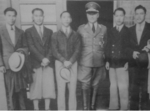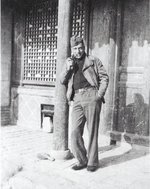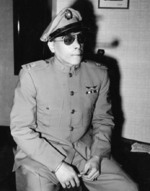Arthur Chin
| Surname | Chin |
| Given Name | Arthur |
| Born | 23 Oct 1913 |
| Died | 3 Sep 1997 |
| Country | China, United States |
| Category | Military-Air |
| Gender | Male |
Contributor: C. Peter Chen
ww2dbaseArthur "Art" Chin (Cantonese: Sui-Tin Chan; Mandarin Pinyin: Ruidian Chen) was born in Portland, Oregon, United States in 1913 to a Chinese immigrant father and a Peruvian mother. His grandfather had originally from Taishan County, Guangdong Province, China, and had served as a diplomat of Qing Dynasty China in Peru. Motivated by the Japanese violation of Chinese sovereignty in 1931, he and 15 other Chinese-Americans enrolled in a Portland-based flying school; their tuition and other expenses were covered by donations from Chinese-Americans on the condition that they would serve the Chinese military against Japanese aggression upon their graduation. After receiving his US pilot's license, he traveled to Guangdong to join the Guangdong Provincial Air Force. He was accepted on 1 Dec 1932 as a Warrant Probationary Pilot. On 23 Feb 1932, he was promoted to the rank of second lieutenant. Between 1935 and 1936, he received advanced flight training with single engined aircraft and multi-engined aircraft at Lagerlechfeld in southern Germany with the Luftwaffe. After returning to China, because the Guangdong Provincial Air Force had merged into the Nationalist central government forces, he became a member of the Chinese Air Force. On 1 Sep 1936, he was promoted to first lieutenant and was assigned the flight leader of the 6th Pursuit Squadron. Between Feb and Jun 1937, he was a flight instructor. On 10 Jun 1937, he was made the commanding officer of the 28th Pursuit Squadron, 5th Pursuit Group.
ww2dbaseOn 15 Aug 1937, after China had entered WW2, Chin's squadron was deployed to the Chuyung Airfield near Nanjing under Captain Chin Kee-Wong. In the afternoon of the same day, he saw combat against Japanese aircraft of Kisarazu Kokutai (Air Group) and claimed two Japanese G3M bombers, but he was not given credit; post-war study of Chinese and Japanese records suggested that he probably did shoot down both Japanese bombers. Early in the morning of 16 Aug, thirteen Japanese G3M Type 96 bombers from Matsuyama Airfield in Taihoku (now Taipei), Taiwan raided military airfields near Nanjing in two separate waves. At 1055, the first wave of six aircraft reached Chuyung Airfield. Chin took off in a Hawk II biplane fighter. Although scoring several hits on a Japanese bomber flown by Lieutenant Osugi, his obsolete aircraft put him at a disadvantage even against bombers, and he suffered several hits. He was forced to make an emergency landing at the nearby Jiaxing Airfield, with his aircraft ending up on its nose as the brakes failed. Later documentation noted that Osugi's aircraft barely made it to Jeju Island, Korea due to fuel loss; although these documents did not specify whether the aircraft crashed during the landing or not, the Chinese Army Air Force awarded Chin with a kill for the purpose of raising morale.
ww2dbaseIn early Sep 1937, 28th Pursuit Squadron was broken up into two detachments, with Chin in command of one of them. He led his detachment, consisted of four Hawk II fighters, to the Shaoguan Aircraft Factory (Postal Map: Shao-kwan) in Guangdong Province, China. On 27 Sep, three G3M bombers attacked the Hankou-Guangdong Raiway, and Chin's group, along with 29th Pursuit Squadron's three Hawk III fighters, took off to intercept. Chin damaged one of the bombers which eventually ran out of fuel and crashed off the coast of Shantou (Postal Map: Swatow), Guangdong Province, China.
ww2dbaseIn late 1937, Chin's squadron was converted to flying British-built Gladiator fighters. On 9 Feb 1938, while ferrying a newly purchased Gladiator fighter from Hengyang, Hunan Province, China for Nanchang, Jiangxi Province, China, Chin crashed into a hill during a snowstorm. He suffered minor injuries to his right eye, and did not fly any missions for the following three months while he recuperated.
ww2dbaseOf the many actions participated and victories achieved in 1938, Chin's 3 Aug 1938 engagement over Hankou, Hubei Province, China was unique. Leading a group of seven Gladiator fighters of Chinese 28th Pursuit Squadron, he drove off Japanese A5M fighters attempting to attack his squadron mates Lieutenant Clifford Louie and Lieutenant Fan Xinmin, but in turn he was heavily damaged by unseen Japanese fighters diving on him from behind. On the night before, his aircraft mechanic had salvaged a piece of armor plating from a wrecked I-15bis fighter and installed it behind his seat, which certainly had saved Chin's life as he recalled hearing shells ricocheting behind him. As he took toll of the situation, he noticed that his fighter was beyond saving, and decided to ram the closest Japanese fighter. He successfully hit his target, causing catastrophic damage to the wing and tail and causing it to spin toward earth, but he also lost control of his aircraft. Gathering all his strength, he was able to clear the cockpit and descended via parachute. A farmer took him in, and then went out to his Gladiator fighter's wreck site to recover a seemingly undamaged machine gun. The farmer helped Chin and the recovered machine gun to a Nationalist base in Hankou, and when Claire Chennault visited Chin at the base hospital, Chin joked whether he could have a mechanic install that particular machine gun on his next fighter.
ww2dbaseOn 1 Dec 1938, Chin was promoted to the rank of major, followed by an assignment as the deputy commander of the 3rd Group on 20 Dec. In Aug 1939, he commanded three Gladiator fighters in support of guerrilla operations in Guangxi Province, China.
ww2dbaseOn 27 Dec 1939, Chin flew a Gladiator fighter in escort of three SB-2 bombers, which were dispatched in support of the Chinese offensive at Kunlun Pass, Guangxi Province. He was shot down when the group was intercepted by Japanese A5M fighters of the 14th Kokutai. He managed to bring his aircraft back to Chinese territory before bailing out near Nanning. With painful facial burns, he remained in a rice paddy until found by Chinese soldiers several days later. He was initially treated at nearby Liuzhou Airfield's field hospital. One night at Liuzhou, with his eyes bandaged shut, air raid sirens sounded. Amidst falling bombs, Chin's wife successfully brought their two sons into the basement, and then, failing to make it back in time to move Chin from the exposed room, she covered him with her own body; she was struck and killed by debris from a nearby bomb blast, saving Chin in the process.
ww2dbaseChin received treatment in Hong Kong, where he would narrowly escape Japanese capture as Japan invaded the British-controlled colony in Dec 1941. After traveling through India and Africa, he arrived in New York, New York, United States, where he would receive skin graft treatment. Upon recovery, he was officially discharged from the Chinese Army Air Force on 1 Mar 1945 so that he could join the United States Army Air Forces to fly supplies over the "Hump" of the Himalayas into China.
ww2dbaseDuring WW2, Chin scored a total of eight victories, all of which were achieved while flying biplane fighters.
ww2dbaseAfter the war, Chin worked for the China National Aviation Corporation until 1950. He was decorated with the Distinguished Flying Cross and the Air Medal on 24 Feb 1995. He passed away in Sep 1997 in Portland, Oregon. On 4 Oct 1997, he was posthumously inducted into the Hall of Fame of the American Airpower Heritage Museum in Midland, Texas, United States. He is now recognized as the first American ace of WW2.
ww2dbaseSources:
Raymond Cheung, Aces of the Republic of China Air Force
Wikipedia
Last Major Revision: Aug 2007
Arthur Chin Interactive Map
Photographs
 |  |  |
Arthur Chin Timeline
| 23 Oct 1913 | Arthur Chin was born in Portland, Oregon, United States. |
| 23 Feb 1932 | Arthur Chin was promoted to the rank of second lieutenant in the Guangdong Provincial Air Force in China. |
| 1 Dec 1932 | Arthur Chin joined the Guangdong Provincial Air Force in China as a warrant probationary pilot. |
| 1 Sep 1936 | Arthur Chin was promoted to first lieutenant and was assigned the flight leader of the Chinese 6th Squadron. |
| 10 Jun 1937 | Arthur Chin was made the commanding officer of 28th Pursuit Squadron of Chinese 5th Pursuit Group. |
| 15 Aug 1937 | Arthur Chin and his 28th Pursuit Squadron was deployed to Chuyung Airfield near Nanjing, China. In the afternoon, he saw combat with aircraft of the Japanese Kisarazu Kokutai. He claimed two G3M bombers, but was not given credit; post-war studies in Chinese and Japanese records showed that he probably should have been given credit for the two victories. |
| 16 Aug 1937 | Arthur Chin, flying a Hawk II fighter, damaged the Japanese bomber piloted by Lieutenant Osugi (Osugi would be forced to land in Korea due to damage) but was in turn damaged. He made a successful emergency landing in a field near Nanjing, China. |
| 27 Sep 1937 | Arthur Chin, flying a Hawk II fighter, damaged a Japanese G3M bomber over the Hankou-Guangdong Raiway in southern China. He ran out of fuel and made a crash landing near Shantou (Postal Map: Swatow), Guangdong, China. |
| 9 Feb 1938 | Arthur Chin, ferrying a Gladiator fighter, crashed into a hill in China during a snowstorm. He suffered minor injuries to his right eye. |
| 31 May 1938 | Arthur Chin, flying a Gladiator fighter, shot down a Japanese E8N floatplane from seaplane carrier Kamikawa Maru north of Hukou, Jiangxi Province, China. |
| 16 Jun 1938 | Arthur Chin, flying a Gladiator fighter, shot down a Japanese G3M bomber near Lechang, Guangdong Province, China. |
| 3 Aug 1938 | Arthur Chin, flying a Gladiator fighter and leading a group of seven Gladiator fighters of Chinese 28th Pursuit Squadron, drove off the two Japanese A5M fighters that were giving chase to Lieutenant Clifford Louie and Lieutenant Fan Xinmin over Hankou, Hubei Province, China. Shortly after, Chin was hit by three A5M fighters diving on him unexpectedly; he was saved by a piece of armor plating installed behind his seat by his mechanic the previous night, which was salvaged from a wrecked I-15bis fighter. Noticing that his fighter was heavily damaged, he rammed into a Japanese fighter, sending both fighters spiraling downard. Chin was able to clear the fighter and descended using a parachute. |
| 1 Dec 1938 | Arthur Chin was promoted to the rank of major. |
| 20 Dec 1938 | Arthur Chin was made the deputy commander of Chinese 3rd Pursuit Group. |
| 6 Jul 1939 | Four Japanese Army Ki-27 fighters strafed ground targets at Pingliang, Gansu Province China. One of the fighters was damaged by ground fire, and its pilot safely landed on the ground and was picked up by another fighter in the group. Chinese troops quickly moved in to capture the relatively good specimen of Japanese technology. Chinese fighter pilot Arthur Chin was sent to study the aircraft; correctly determining that it was flyable, he brought the fighter to a Chinese airfield for further evaluations. |
| 2 Nov 1939 | Arthur Chin, flying a Gladiator fighter, damaged a Japanese Navy C5M reconnaissance aircraft over Wuming Airfield, Guangxi Province, China. Observer Sub-Lieutenant Yonetaro Ueda was seriously injured, but the pilot was able to nurse the damaged aircraft back to its base on Hainan Island off the southern Chinese coast. |
| 27 Dec 1939 | Arthur Chin, flying a Gladiator fighter, escorted three SB-2 bombers (flown by Soviet volunteer crews) in a mission against Japanese positions near Kunlun Pass near Nanning, Guangxi Province, China. He shot down a Japanese A5M fighter which was attacking Lieutenant Chen Yexin's I-15bis fighter, but he was in turn hit by another A5M fighter. He successfully bailed out of his burning fighter, but not before he suffered serious burns to his face. |
| 1 Mar 1945 | Arthur Chin was officially discharged from the Chinese Air Force so he could join the United States Army Air Forces to fly supplies over the "Hump" of the Himalayas into China. |
| 24 Feb 1995 | Arthur Chin was awarded the Distinguished Flying Cross and the Air Medal. |
| 3 Sep 1997 | Arthur Chin passed away in Portland, Oregon, United States. |
| 4 Oct 1997 | Arthur Chin was posthumously inducted into the Hall of Fame of the American Airpower Heritage Museum in Midland, Texas, United States. |
Please consider supporting us on Patreon. Even $1 per month will go a long way! Thank you. Please help us spread the word: Stay updated with WW2DB: |
Visitor Submitted Comments
8 Feb 2013 09:38:27 AM
It was my honor to met Art in the mid 1950's when I was in my mid 20s. Art was a man I admired and respected not just for his courage and dedication to "doing his duty" but for his humility and love of family and country.
All visitor submitted comments are opinions of those making the submissions and do not reflect views of WW2DB.
» Burma Road and the Hump
» Winter Offensive
Associated Aircraft:
» Gladiator
Related Books:
» Aces of the Republic of China Air Force
- » 1,165 biographies
- » 337 events
- » 44,601 timeline entries
- » 1,243 ships
- » 350 aircraft models
- » 207 vehicle models
- » 376 weapon models
- » 123 historical documents
- » 261 facilities
- » 470 book reviews
- » 28,615 photos
- » 429 maps
General Douglas MacArthur at Leyte, 17 Oct 1944
Please consider supporting us on Patreon. Even $1 a month will go a long way. Thank you!
Or, please support us by purchasing some WW2DB merchandise at TeeSpring, Thank you!
18 Sep 2007 02:10:28 AM
The Chinese Government purchased thirty-six Gladiator Fighters. Although many of these were destroyed in training accidents and by aerial attack the survivors achieved many successes against the Japanese, particullarly in the defence of the Siuchow aircraft factory.